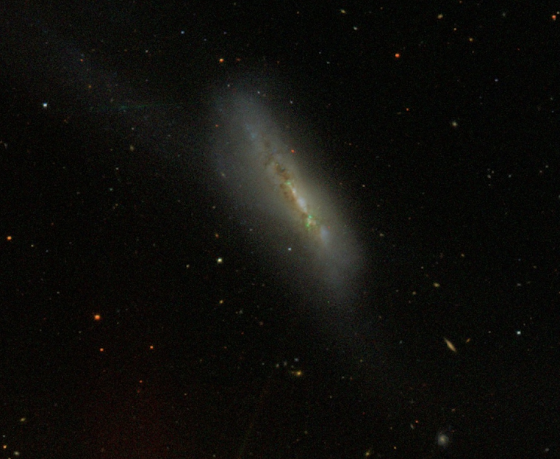Gazing into the vast expanse of the universe, our telescopes unveil a multitude of galaxies, each with its own story to tell. Amongst these celestial wonders lies NGC 4747, a barred spiral galaxy that holds a unique place in the cosmos. In this blog, we embark on a captivating journey to explore the depths of NGC 4747, unraveling its distance, age, size, and the fascinating dance it participates in with its neighbors.
A Glimpse from Afar: Distance and Size
NGC 4747 resides roughly 35 million light-years away from Earth, a staggering distance that translates to traveling at the speed of light for 35 million years! Despite its immense remoteness, astronomers can discern its majestic form through powerful telescopes. While it appears relatively small in our night sky with an apparent size of 3.5 x 1.2 arcminutes, its true scale is mind-boggling. Estimates suggest that NGC 4747 boasts a diameter of around 35,000 light-years, a vast expanse where stars are born, live, and die.
A Journey Through Time: Age and Star Formation
Pinpointing the exact age of an individual galaxy remains a challenge for astronomers. However, considering the billions of years galaxies like our Milky Way are estimated to be, NGC 4747 likely formed around the same time frame along with its companions in the surrounding cosmic neighborhood. Interestingly, ongoing star formation has been observed within NGC 4747. This process, where interstellar gas condenses and ignites, giving birth to new stars, paints a picture of a dynamic galaxy brimming with stellar activity.
Mass and Composition: Unveiling the Unseen
The exact mass of NGC 4747 remains a cosmic mystery. By analyzing its luminosity, the total amount of light it emits, astronomers believe it possesses less mass compared to our Milky Way galaxy. However, the presence of ongoing star formation hints at the existence of vast reservoirs of gas and dust within its spiral arms, hinting at a complex composition that shapes its overall mass.
A Celestial Spectacle: Stars and Interactions
While the immense distance makes it impossible to resolve individual stars within NGC 4747, astronomers can study its overall stellar population by meticulously dissecting the galaxy's light. This analysis provides valuable insights into the types and ages of stars that illuminate NGC 4747.
However, the story of NGC 4747 goes beyond its stellar inhabitants. This galaxy is classified as "peculiar," a designation earned due to its distorted shape. This warped form isn't a coincidence; it's a consequence of a dramatic cosmic ballet. NGC 4747 is locked in a gravitational interaction with its neighbor, the much larger spiral galaxy NGC 4725. The immense tidal forces exerted by NGC 4725 are believed to be responsible for the long, wispy tails of gas and dust extending from NGC 4747. These tails, stretched like celestial ribbons, offer a captivating glimpse into how galactic encounters can trigger star formation within the affected galaxy.
A Cosmic Neighborhood: Neighbors and the Coma I Group
NGC 4747 isn't a solitary island in the cosmic ocean. It shares its celestial space with its dominant neighbor, NGC 4725, whose gravitational influence shapes its form. But the cosmic drama extends further. NGC 4747 is considered part of the Coma I Group, a collection of galaxies nestled within the vast Local Supercluster. This group structure hints at the interconnected nature of the universe, where galaxies aren't isolated entities but members of a grander cosmic web.
A Storied Past and a Unique Future: History and Uniqueness
NGC 4747's journey through time began when it was first discovered by William Herschel in 1785. Since then, it has become a subject of fascination for astronomers, particularly due to its peculiar appearance and the ongoing interaction with NGC 4725. Studying NGC 4747 allows us to understand how galactic encounters can distort shapes, trigger star formation, and leave behind dramatic tidal tails. Its status as a peculiar galaxy highlights its uniqueness compared to the more symmetrical spiral galaxies that populate the universe.
In conclusion, NGC 4747 stands as a testament to the captivating dynamics of the cosmos. Its distorted form, ongoing star formation, and dance with its neighbor unveil a galaxy brimming with activity. As we delve deeper into the universe, NGC 4747 serves as a reminder of the interconnectedness of galaxies and the captivating stories etched in their celestial forms.


Comments
Post a Comment